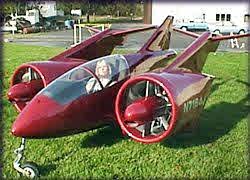- Many of us will spend months over the
course of our lives sitting in traffic jams. But what if you could rise
above all that literally?
-
- A Davis, Calif.,
engineer with a distaste for traffic has come up with what he thinks will
be the commuters dream of the 21st century: a small aircraft he calls the
Skycar.
-
-

-
-
- "[The Skycar
is] the personalized vehicle that can take you up from your driveway and
transport you where you want to go, when you want, and then land you pretty
much exactly where you want," says Dr. Paul Moller, founder of Moller
International.
-
- No Runways Needed
-
- The Skycar takes off much like a helicopter,
yet flies like a jet. Moller uses a Vertical Take-Off and Landing (VTOL)
system, much like the one used in Britains Harrier fighter aircraft. The
engines swivel so that on takeoff, the thrust pushes the aircraft upward.
The engines then swivel horizontally to drive the aircraft forward.
-
- As Moller himself
notes, he is not the first inventor to attempt to develop a small personal
aircraft. According to Moller International promotional material, "Past
efforts by other companies to do this have resulted in exorbitantly expensive
aircraft in which a minor component failure during hover often led to catastrophic
results."
-
- But the Skycar
has some advantages over past aircraft. Moller has made more than 150 hovering
and low-speed flights - the most critical flight mode of any VTOL vehicle.
It's been clocked it at 390 mph, and its 960-horsepower engine runs on
standard automobile gasoline. It gets 15 or more miles to the gallon. It's
somewhat bigger than an average car - 18 feet long and 9 feet wide - but
smaller than a two-seat aircraft like a Cessna Skyhawk, which has a 36-foot
wingspan. Early models will cost around $1 million
- not exactly inexpensive - but Moller claims that mass production could
bring the price down to around $60,000.
-
- Aerial Traffic Jams?
-
- Moller International has also developed
an 'aerobot,' an unmanned flying robotic vehicle. The company has sold
aerobots to the U.S. Air Force (for airfield damage assessment) and to
the California Department of Transportation (for aerial inspection of bridges
and overpasses). Moller believes he could have a breakthrough product with
the Skycar. "I was astounded at how extremely
well thought-out the whole project actually was," says Henry Lahore,
a systems engineer at Boeing. He says the Skycar is "very airworthy."
Airborne commuters wont need extensive training,
Moller says, because the Skycar is piloted by computer. To avoid potentially
fatal mid-air accidents, the computers would use pre-programmed courses
that Moller likens to 'traffic lanes.' If Mollers
vision comes to pass, commuters would no longer be tied to the cities.
That half-hour commute might only cover 20 miles on the ground, but in
the air, the Skycar could travel 200 miles in the same amount of time.
"At some point in time," Moller says
as he gazes skyward, "were going to use this great natural resource
that's essentially unused."
|